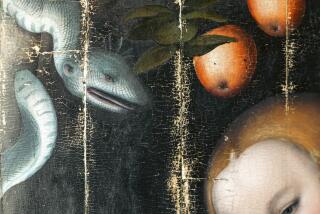Owner rejects analysis of unsubstantiated Pollocks
BOSTON — The owner of three paintings attributed to contemporary abstract painter Jackson Pollock has rejected a scientific analysis by Harvard University researchers that questions the age and authenticity of the works.
Researchers at the Harvard University Art Museums tested paint pigments and binding media in the three paintings. They found that pigments used in all three works were not commercially available until after Pollock’s death in 1956. The orange paint in one of the paintings contained a pigment that was not available until 1971. Brown paint found in another painting likely was developed in the early 1980s and came onto the market in 1986.
Alex Matter, son of late photographer Herbert Matter, one of Pollock’s close friends, found the paintings in 2002 among a store of 32 works wrapped in brown paper at his father’s storage locker on New York’s Long Island. A photograph Matter provided to the Harvard researchers shows the brown paper inscribed with words and dates suggesting the paintings were created, bought or gifted between 1946-49.
“The authentication of works of art is still more art than science,” Matter said in a written statement posted on his website. “The point is that the science of attribution is still in flux, and no scientific test is definitive in the absence of traditional, time-tested art historical research.”
He said that varnish used to restore the paintings could have contaminated paint samples tested in the Harvard study. Matter also noted the Harvard researchers carbon dated the blue illustration cardboard backing of the paintings and found they were produced in the 1950s before Pollock’s death.
Two works contained media that were most likely not available until 1962 or 1963, according to the Harvard report. The researchers wrote that the binding medium used to create silver paint on a third painting “in all likelihood was not commercially available until the 1970s.”
Conservation treatment could account for clear coating and adhesives found on one of the paintings, the report said, “but not the terpolymer medium that binds the pigment to form the paint, or the very modern pigments, which were found in untreated areas.”
“It would be nice if there were a definitive answer, but this does not help the case,” said Helen Harrison, director of the Pollock-Krasner House and Study Center, the definitive Pollock museum. The center supplied a blue illustration board similar to the supports of the three works studied, used for comparison.
Narayan Khandekar, the lead researcher on the 14-month, pro bono study, said scientific testing should play an important role in determining the authenticity of Matter’s potential Pollocks.
“You can’t just dismiss this one piece of evidence. That’s not the right way to approach a scholarly discussion,” he said Tuesday. “You have to have an art historian and a connoisseur who uses his or her eye and the scientist has to play a role in that.”
Khandekar said the Harvard study did not say the paintings were not Pollock’s creations, but strongly suggested that they were at least altered after the artist’s death.
“You can join those dots,” he said. “They are laid out and people can use that evidence to draw those conclusions.”
In the mid-1940s, Pollock introduced radical innovations to a new form of painting that would become Abstract Expressionism. He used pour and drip techniques, and instead of brushes, he manipulated paint with sticks, trowels and knives. He would sometimes add sand, broken glass, thumbtacks and other foreign materials to his paint.
The 32 works that Matter attributes to Pollock have been subjected to fractal examinations that compare the paintings with Pollock’s distinct dripping technique, expert analysis at the Pollock-Krasner House, and a range of other tests. But the scholars have not reached any consensus.
The McMullen Museum of Art at Boston College will display 25 of Matter’s disputed Pollock paintings beginning Sept. 1 in an exhibit titled “Pollock Matters.”
More to Read
The biggest entertainment stories
Get our big stories about Hollywood, film, television, music, arts, culture and more right in your inbox as soon as they publish.
You may occasionally receive promotional content from the Los Angeles Times.










